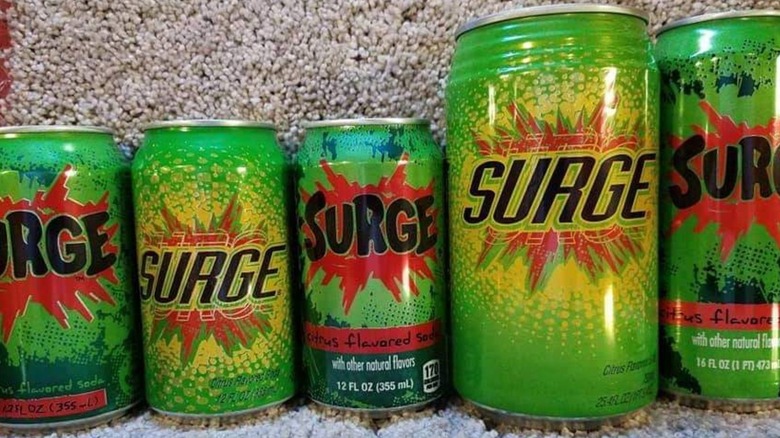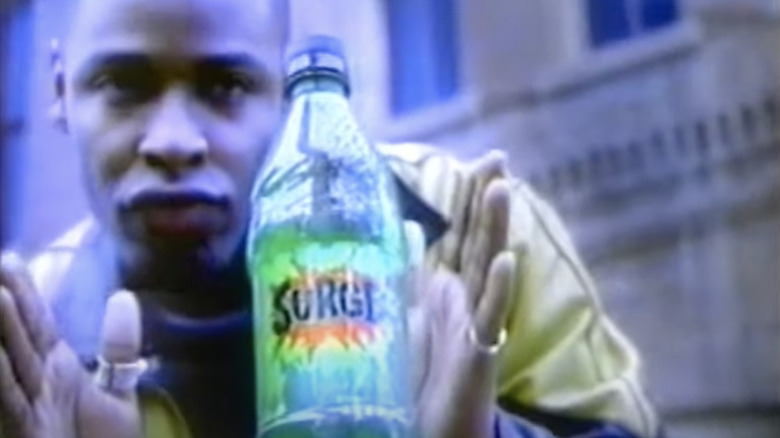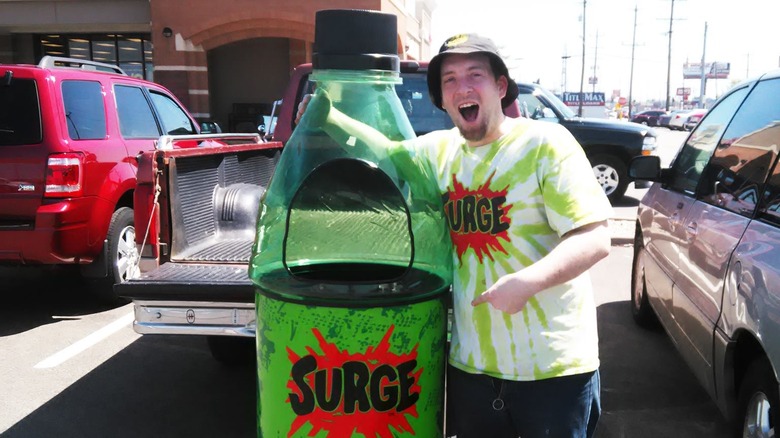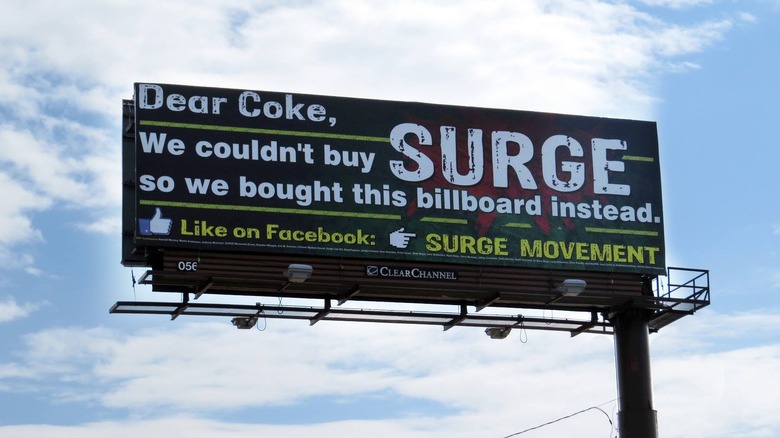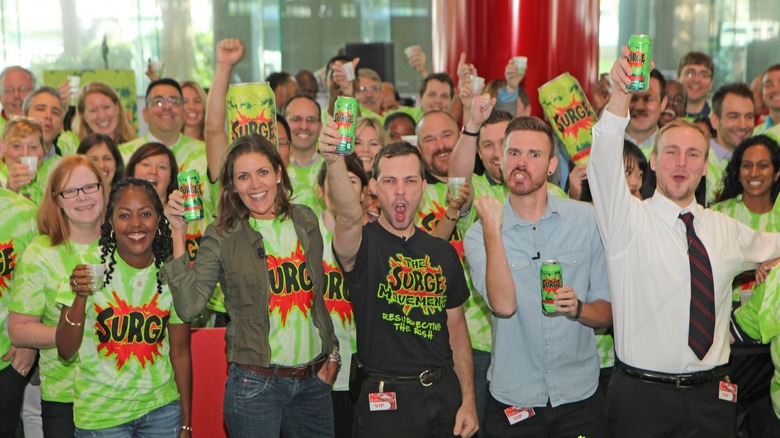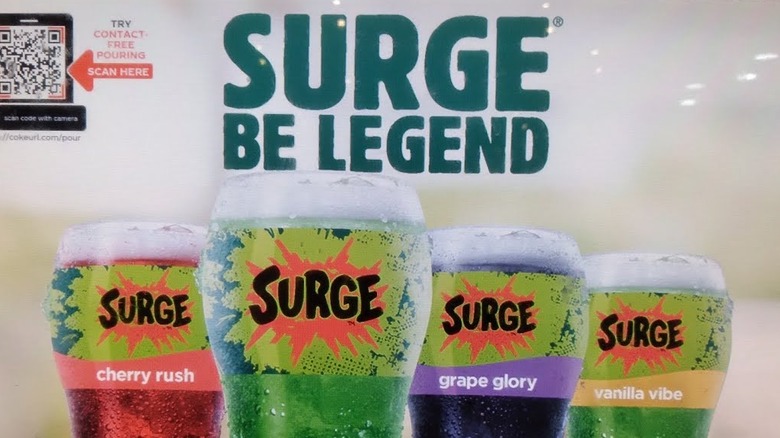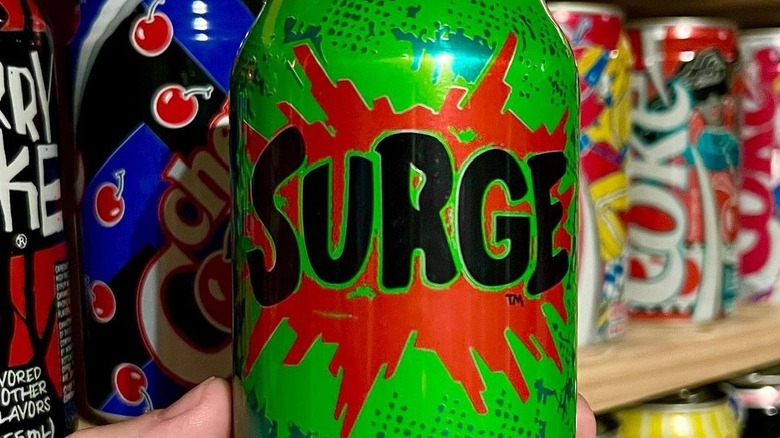Whatever Happened To SURGE?
Only '90s kids will get this — the snacks, that is. The decade saw an era of such iconic treats as Dunkaroos, French Toast Crunch, and Heinz EZ Squirt Colored Ketchup. Some of these nostalgic childhood snacks were so beloved by now-grown-up fans that they've enjoyed comebacks on modern grocery store shelves. Among these comebacks is SURGE soda: A middle-schooler's heedless, passionate fantasy and a parent's worst nightmare.
SURGE was first released in 1997 as Coca-Cola's response to Pepsi's Mountain Dew. SURGE is a citrus-flavored, energy-drink-adjacent soda packed with maltodextrin; an additive many athletes use as a dietary supplement, per Medical News Today. The marketing campaign was a glorious spectacle starring teenage angst, total abandon, and reckless physical expression at least as much as the drink itself. One commercial from 1997 depicts a group of young men on a city street, rapidly climbing over discarded couches and furniture, racing each other to reach a single bottle of SURGE. Another ad from 1998 shows another group of young men, this time battling each other for the drink before eventually grabbing the bottle, spraying the carbonated foam across the camera lens, and screaming while heavy guitar music plays. Truly a triumph of the human spirit.
Despite its seemingly successful run, Coca-Cola discontinued SURGE in 2003. Perhaps the beverage's sales didn't meet revenue expectations too many adolescents ended up with broken wrists, or asked their folks for a skateboard one too many times. So, whatever happened to it?
Surge was released in 1997
SURGE gained popularity swiftly following its release in 1997. In order to compete with Mountain Dew and make a big splash in America's citrus beverage market, Coca-Cola invested lots of money into advertising. In fact, according to The Surge Movement, the first official commercial was aired during Super Bowl XXXI. The commercial perfectly depicted the reckless abandon of youthful expression, which encapsulated everything SURGE represented. Its initial introduction proved to be a success in gaining the attention of the teenage demographic. Internal consumer research found that up to 95% of the teens in SURGE's initial launch market had tasted it at least once. The brand would become known for commercials that centered around "Extreme Lifestyle" activities — think Redbull, but years before the term "energy drink" was common.
Bright green-colored and described as a "Fully Loaded Citrus Soda with Carbos," SURGE was nearly identical to its competition. Despite the similarities marketing-wise to Mountain Dew, Surge actually contained fewer calories, caffeine, and sugar. Fortunately, the colorful and cool '90s was the perfect era for SURGE. Although its popularity would eventually wane, it amassed a cult following that solidified it as an iconic piece of pop culture.
Why was Surge discontinued?
After its initial surge in success, a changing of the guard would soon signal a decline. Sergio Zyman, who was the head of Coca-Cola's marketing department for the launch, resigned in April of 1998 and was replaced by Charles S. Frenette. Apparently, the two men had different methods of marketing, and Frenette's approach didn't necessarily align with SURGE's youth-centric model. The change not only caused Coca-Cola's stock to decline but also sales of SURGE — a decline that continued until it was discontinued in 2003.
Another thing that contributed to the decline was a rumor that SURGE caused "adverse effects." There was misinformation spread about it containing high levels of sugar and caffeine. In response to the rumors, schools began removing it from vending machines and parents stopped satiating their children's SURGE obsession. The reality is that SURGE was actually a healthier alternative to its rival, Mountain Dew. It's unclear how the rumors began, but in an era famous for junk food, it's odd that this particular soda caught a bad rep.
The news of SURGE's impending discontinuation sent a shockwave through its fanbase. A website named SaveSURGE.org was established for fans to contest the decision. The site's founder, Eric "Karks" Karkovack, made a petition which subsequently garnered over 30,000 signatures. As further proof that the cult of SURGE is real, a map was even created that listed the last remaining spots that carried it.
Fans begged for Surge and Coca-Cola instead delivered Vault
Feeling the outcry from fans, in 2005, Coca-Cola decided instead to release a completely new citrus-flavored beverage named Vault Soda. By this time, energy drinks were beginning to become popular, yet they were known to leave an undesirable aftertaste. Vault Soda was marketed as a hybrid beverage that quenches your thirst like Sprite while giving you an energy boost like Coke. Compared to SURGE, an 8 fl oz serving (or a half-can) of Vault Soda contained 47 mg of caffeine. That is nearly the same amount as a full 12 fl oz can of SURGE. Advertisements featured slogans like "Chug & Charge" and "Get it Done!" Along with its original flavor, Vault was later expanded into a line that included zero-sugar, grape, peach, and more.
There's no clear reason why Coca-Cola released Vault rather than simply reintroducing SURGE. The move was a clear indication that they wanted a piece of the citrus soda market and felt that Vault's energy-drink characteristics and taste set it apart. Despite its youthful get-up-and-go marketing, Vault failed to have the same impact as SURGE. It only graced store shelves for six years before being discontinued in 2011. Coca-Cola's attempt at a citrus-flavored money grab didn't stop or silence fans of SURGE either. On the contrary, it inspired petitions, websites, and even the formation of The Surge Movement.
The Surge Movement led to the drink's return
While it's fairly common for fans to coral around a beloved discontinued product, the fandom for SURGE is cult-like. The Surge Movement was founded by Evan Carr in December of 2011. It began as a Facebook group before growing to become a major voice in the fight for SURGE's return. In order to raise awareness and influence Coca-Cola to reverse its decision, the guerrilla marketing-style movement used social media and a grassroots approach. Furthermore, The Surge Movement actually cared about ensuring it was a profitable decision for Coca-Cola.
Shortly after launching The Surge Movement, the page began to average over a thousand fans each month. Calls to Coke's Consumer Affairs hotline were encouraged, leading to the creation of "SURGE Coke" Day, an ongoing event centered around galvanizing followers to call. In 2012, a crowdsourcing campaign was created to fund a billboard half a mile from Coca-Cola HQ. The initial goal was $3,745, but the movement was able to raise $3,837.
A month later, the billboard was finally constructed and read, "Dear Coke, we couldn't buy SURGE, so we bought this billboard instead." Despite coverage from notable outlets, it took another year of campaigning for Sandy Douglas, the President of Coca-Cola North America, to finally respond: "Evan, thanks for your ongoing interest in Surge. We are working on a plan to make Surge available again by popular demand, and we will follow up with you as soon as it's ready. Thanks."
Surge became available again in 2014
As of September 15th, 2014, SURGE has returned, albeit in limited availability. Amazon was the first retailer to sell it, and it subsequently surged to the top of the site's best-selling list and sold out within an hour. Walmart followed in 2015, marking the first official time Surge had been available at a physical location since it was discontinued. That same year, Coca-Cola also made it available at many Coke retailers nationwide. Its initial return was only the beginning; SURGE's reintroduction would unravel in surprising ways.
Burger King joined in on the soda craze and released a limited edition frozen Surge — basically, a citrus-flavored slushy. The commercial again stoked the flames of nostalgia by featuring another '90s legend: Pauley Shore. In a press release for the new chilly treat, Bobby Oliver, director of citrus brands at Coca-Cola North America, said to Business Wire, "The popularity of SURGE has stood the test of time and the overwhelming demand from fans drove our decision to bring it back." Popular movie theater brand Cinemark also caught a case of Surge-mania and added Frozen SURGE to 335 of its locations.
Coca-Cola continued to expand the SURGE-effect by introducing new flavors like SURGE Red Berry Blast, SURGE Zero, SURGE Vanilla Vibe, SURGE Cherry Rush, and SURGE Grape Glory. The additional flavors were only sold at select gas stations and Burger Kings through Coca-Cola's Freestyle machine.
Can you still buy Surge today?
The hype of its return has died down in recent years. SURGE has yet to see the widespread adoration that it received in the '90s. Nevertheless, Coca-Cola still offers it in super limited availability. A quick search on SURGE's website only turned up Amazon, Walmart, and Instacart as results — a deeper dive revealed that most locations were, sadly, out of stock. An online search for nearby retailers says that it's available at BevMo and Safeway, which may indicate its potential availability at other regional grocery outlets.
The carbonated beverage game isn't what it used to be, though, and with so many new sodas to try, it's unlikely SURGE will ever return to its former glory. The SURGE Movement continues on, though, serving as a hub for hardcore fans, who, while small in number, have a large amount of love for this citrusy classic. The homepage of its website still features an active blog of posts made by SURGE-lovers from Facebook. If anything, it's a testament to the lasting spirit of the '90s.
